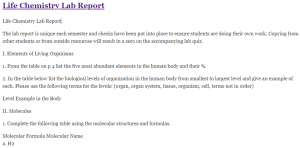Life Chemistry Lab Report
Life Chemistry Lab Report
The lab report is unique each semester and checks have been put into place to ensure students are doing their own work. Copying from other students or from outside resources will result in a zero on the accompanying lab quiz.
I. Elements of Living Organisms
1. From the table on p 4 list the five most abundant elements in the human body and their %.
2. In the table below list the biological levels of organization in the human body from smallest to largest level and give an example of each. Please use the following terms for the levels: (organ, organ system, tissue, organism, cell, terms not in order)
Level Example in the Body
II. Molecules
1. Complete the following table using the molecular structures and formulas.
Molecular Formula Molecular Name
a. H2
b. C6H12O6
c. H2NCH(CH3)COOH
d. C2H5OH
e. CO2
f. Ch4
g. H2O
2. List the name and number atoms in the glucose molecule. See Ex 1, p 9
3. Using lab, Sec. II, and the table on p 11 draw and label a ball and stick representation of these molecules: H2, H2O, CO2, CH4 Use circles to designate atoms and lines for bonds, then indicate the chemical symbol for each atom. Prepare an image of your drawing and include it with this lab report.
4. Complete the following table showing the number of electrons each atom can share. Each shared electron is represented by a – connecting two atoms.
Atom # of electrons
shared with other atoms
hydrogen
oxygen
carbon
III. Molecular Make Up of Living Organisms
1. Give an example of a food that is primarily made up of the following organic molecules.
Monosaccharide:
Polysaccharide:
Lipid:
Protein:

Life Chemistry Lab Report
2. Use Ex 2, 3, 4 p 6-12 to complete the following table:
Organic Molecule Reagent Sample Tested Positive Color Negative Color
Carbohydrate (starch) Iodine
Sugar Benedict’s solution
Lipid (fat) Sudan IV
Protein Biuret
3. Using Ex 6 p 19-20 watch the video demonstrating the slide making process and application of the reagent. Note where in the cell Lugol’s iodine shows a positive reaction. Describe the microscopic image of a potato cell with starch granules. Identify the color and location of the positive reaction of iodine within the cell.
IV. Measurement of pH
1. Using the pH scale on p 2, complete the following table:
Name of
Category pH Range
Numbers Ion Released in Solution Color of
Reagent Examples of
Solutions
acid
neutral
base
2. Watch the video in Ex 7 that tests the pH of common solutions.
The neutral solution is
The most acidic solution is
The most basic solution is
Summary Questions
1. For each of the following organic molecules complete the table.
Name of molecule Reagent used to test for this molecule Positive
reaction color
in solution Examples of foods primarily made of this molecule
Sugar
Starches
Lipids
Proteins
2. Each type of organic molecule was tested using a different reagent. Which reagent solution needs to be put in boiling water in order to see a color change?
3. A friend complains of GERD (acid reflux). He is taking Tums an antacid. What chemical nature of the product neutralizes stomach acid? Explain your answer using what you know about the ions in acids and bases.
4. List the four most common atoms in the human body from most abundant to least.
5. Name at least three organic molecules found in the human body that contain these atoms.
Do you need a similar assignment written for you from scratch? We have qualified writers to help you.
You can rest assured of an A+ quality paper that is plagiarism free. Order now for a FREE first Assignment!
Use Discount Code "FREE" for a 100% Discount!
NB: We do not resell papers. Upon ordering, we write an original paper exclusively for you.

